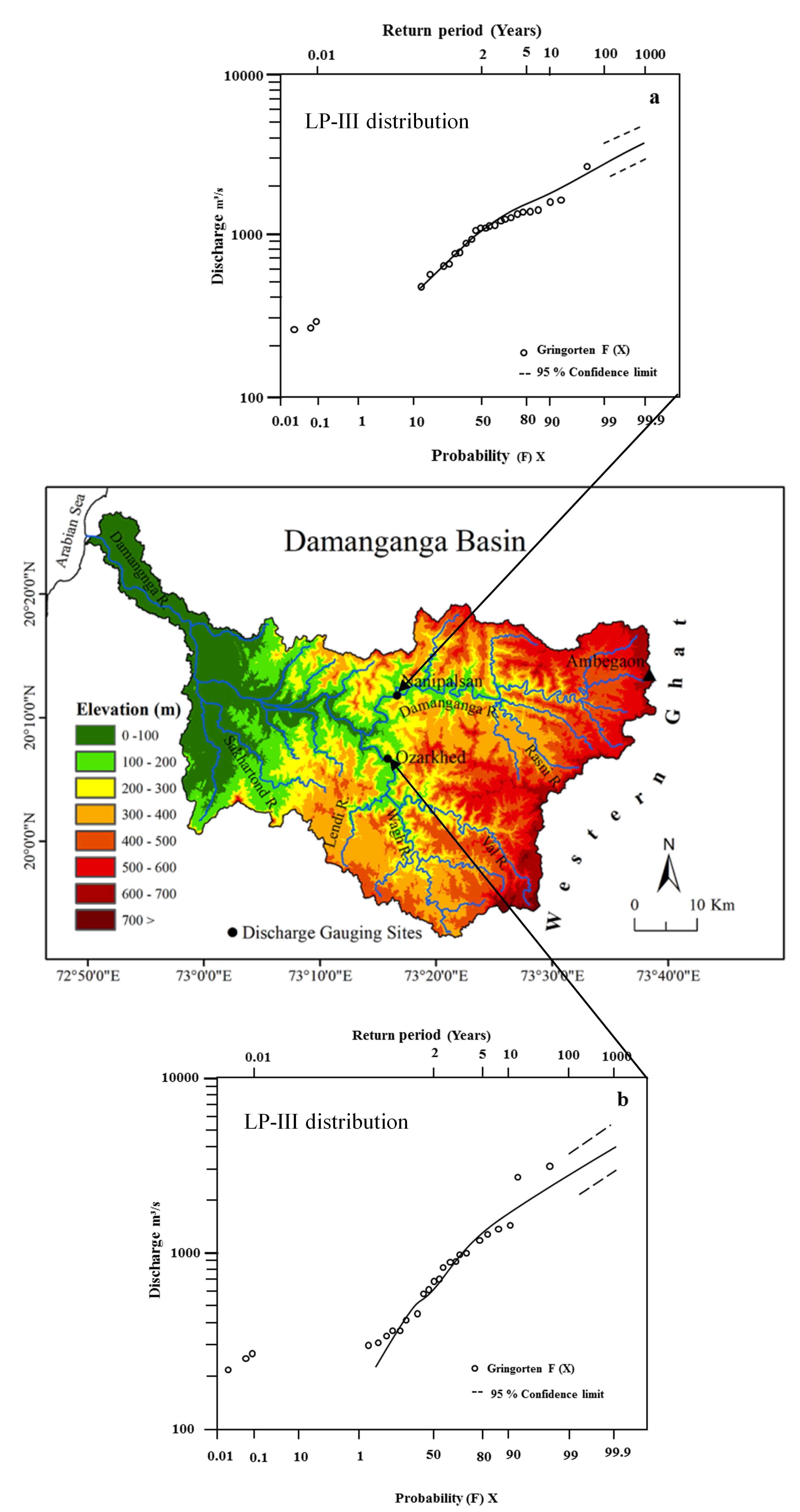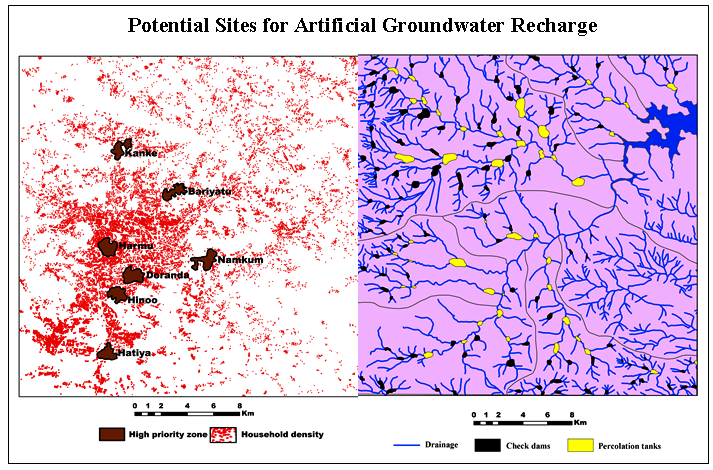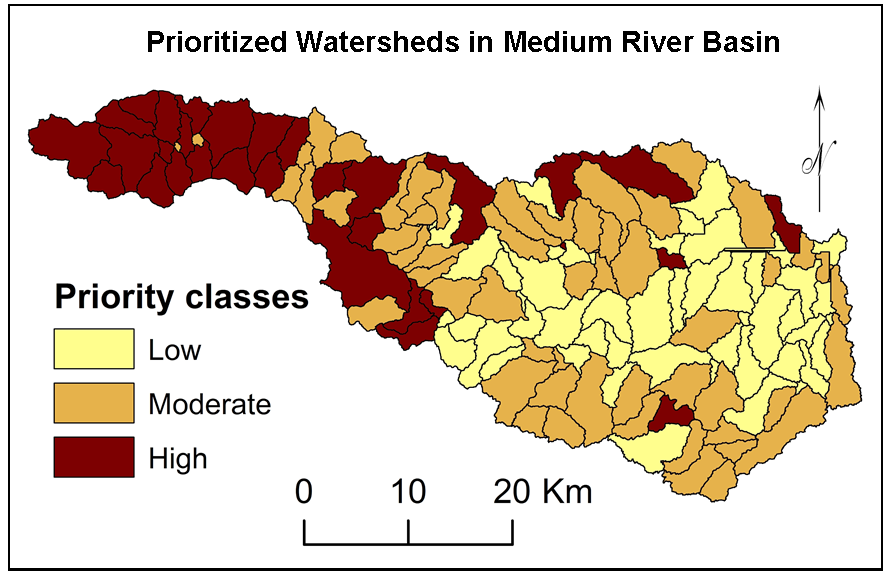Article Title :
Analysis of Magnitude and Frequency of Floods in the Damanganga Basin: Western India 
5 (2021)
1-11
Damanganga Basin , Flood Frequency , Gumbel Extreme Value type I , Log Pearson Type III


Flood Frequency Analysis (FFA) method was introduced by Fuller in 1914 to understand the magnitude and frequency of floods. The present study is carried out using the two most widely accepted probability distributions for FFA in the world namely, Gumbel Extreme Value type I (GEVI) and Log Pearson type III (LP-III). The Kolmogorov-Smirnov (KS) and Anderson-Darling (AD) methods were used to select the most suitable probability distribution at sites in the Damanganga Basin. Moreover, discharges were estimated for various return periods using GEVI and LP-III. The recurrence interval of the largest peak flood on record (Qmax) is 107 years (at Nanipalsan) and 146 years (at Ozarkhed) as per LP-III. Flood Frequency Curves (FFC) specifies that LP-III is the best-fitted probability distribution for FFA of the Damanganga Basin. Therefore, estimated discharges and return periods by LP-III probability distribution are more reliable and can be used for designing hydraulic structures.

Damanganga Basin shows significant spatio-temporal variability in rainfall.
Monsoon rainfall control magnitude of the annual maximum discharges.
Flood frequency analysis is essential for construction of future hydraulic structures.
Log Pearson type III is best-fitted probability distribution for Damanganga Basin.
Beard, L. R., 1975. Generalized evaluation of flash-flood potential. Technical Report: University of Texas, Austin. Central Research Water Resource, CRWR- 124, 1-27.
Bedient, P. B., and Huber, W.C., 1989. Hydrology and Floodplain Analysis. Addison Wesley Publication Company, New York.
CWC [Central Water Commission], 2018. West-flowing rivers, Water year book 2017-18. Narmada and Tapi Basin Organization, Hydrological Observation Circle, Gandhinagar, Gujarat.
Chow, V. T., Maidment, D. R., and Mays, L. W., 1988. Applied Hydrology. McGraw Hill, New York.
Foster, H. A., 1924. Theoretical frequency curves and their application to engineering problems. Transaction of the American Society of Civil Engineers, 87 (1), 142-173.
Fuller, W. E., 1914. Flood flows. Transactions of the American Society of Civil Engineers, 77 (1293), 564-617.
Garde, R. J., 1998. Floods and flood control: engineering approach. In: V.S. Kale (Ed.), Flood studies in India. Memoir of Geological Society of India, 41, 173-193.
Gumbel, E. J., 1941. The return period of flood flows. Annals of Mathematics and Statistics, 12, 163-190.
Gumbel, E.J., 1958. Statistics of Extremes. Columbia University Press, New York.
Hire, P. S., 2000. Geomorphic and hydrologic studies of floods in the Tapi Basin. Unpublished Ph.D. Thesis, University of Pune, Pune, India.
Hire, P. S., and Patil, A. D., 2018. Flood frequency analysis of the Par River: Western India. International Journal of Scientific Research in Science and Technology, 5 (1), 164-168.
Hosking, J. R. M., and Wallis, J. R., 1997. Regional Frequency Analysis- An Approach Based on L-Moments. Cambridge University Press, Cambridge, 224.
Jha, V. C., and Bairagya, H., 2011. Environmental impact of flood and their sustainable management in deltaic region of West Bengal, India. Caminhos de Geografia, 12 (39), 283-296.
Kale, V. S., and Gupta, A., 2010. Introduction to Geomorphology. Universities Press Pvt. Ltd., India.
Law, G. S., and Tasker, G. D., 2003. Flood frequency prediction methods for unregulated streams of Tennessee, 2000. Water Resources Investigations Report, 03-4176, Nashville, Tennessee.
Millington, N., Das, S., and Simonovic, S.P., 2011. The comparison of GEV, Log-Pearson Type 3 and Gumbel distributions in the Upper Thames River watershed under global climate models. Water Resources Research Report, Department of Civil and Environmental Engineering, University of Western Ontario.
Patil, A. D. 2017. Bedrock channel of the Par River: its forms and processes. Unpublished Ph.D. Thesis, Tilak Maharashtra Vidyapeeth, Pune.
Pawar, U. V., 2019. An analytical study of geomorphological, hydrological, and meteorological characteristics of floods in the Mahi River Basin: Western India. Unpublished Ph.D. Thesis, Tilak Maharashtra Vidyapeeth, Pune, India.
Prasad, T., and Subramanya, K., 1986. Design flood computation with limited data - Case study of a reservoir in Subernrekha River Basin. Proceedings of the International Symposium on Flood Frequency and Risk Analyses, 14-17 May 1986, Louisiana State University, Baton Rouge, U.S.A
Raghunath, H. M., 2006. Hydrology: principles, analysis, and design. Second revised edition.
Shaw, E. M., 1988. Hydrology in Practice. Van Nostrand Reibhold Int. Co. Ltd., London.
Shaw, E. M., 1994. Hydrology in Practice. Taylor & Francis e-Library, 2005.
USWRC [U. S. Water Resources Council], 1967. A uniform technique for determining flood flow frequencies, Bulletin No. 15. Washington D.C.
USWRC [U. S. Water Resources Council], 1976. Guidelines for determining flood flow frequency, Bulletin No.17.Washington D.C.
USWRC [U. S. Water Resources Council], 1981. Guidelines for determining flood flow frequency, Bulletin No. 17B. Washington D.C.
Watt, W. E., Lathem, K. W., Neill, C. R., Richard, T.L., and Rousselle, J., 1989. Hydrology of floods in Canada: A Guide to Planning and Design. National Research Council of Canada.






